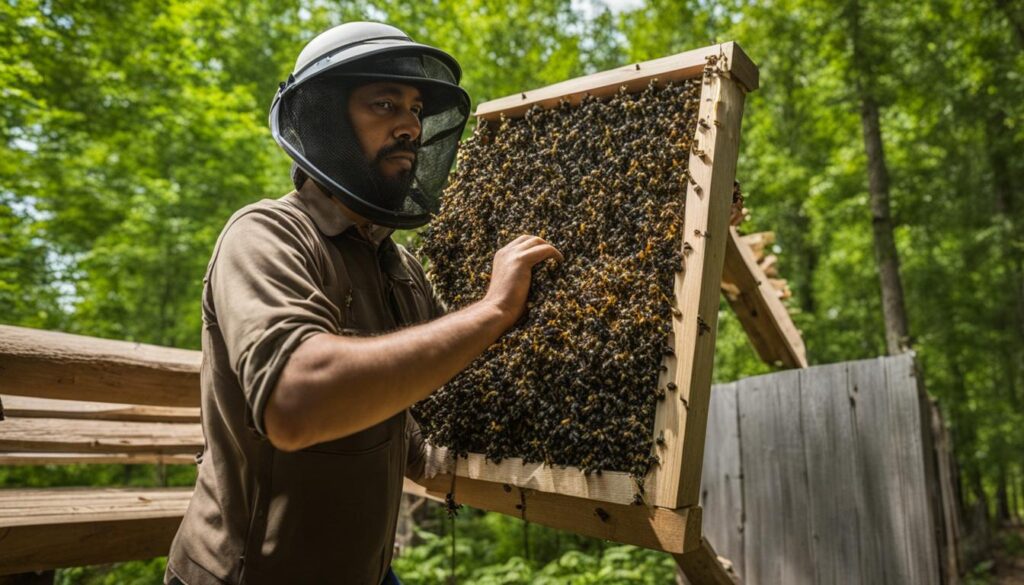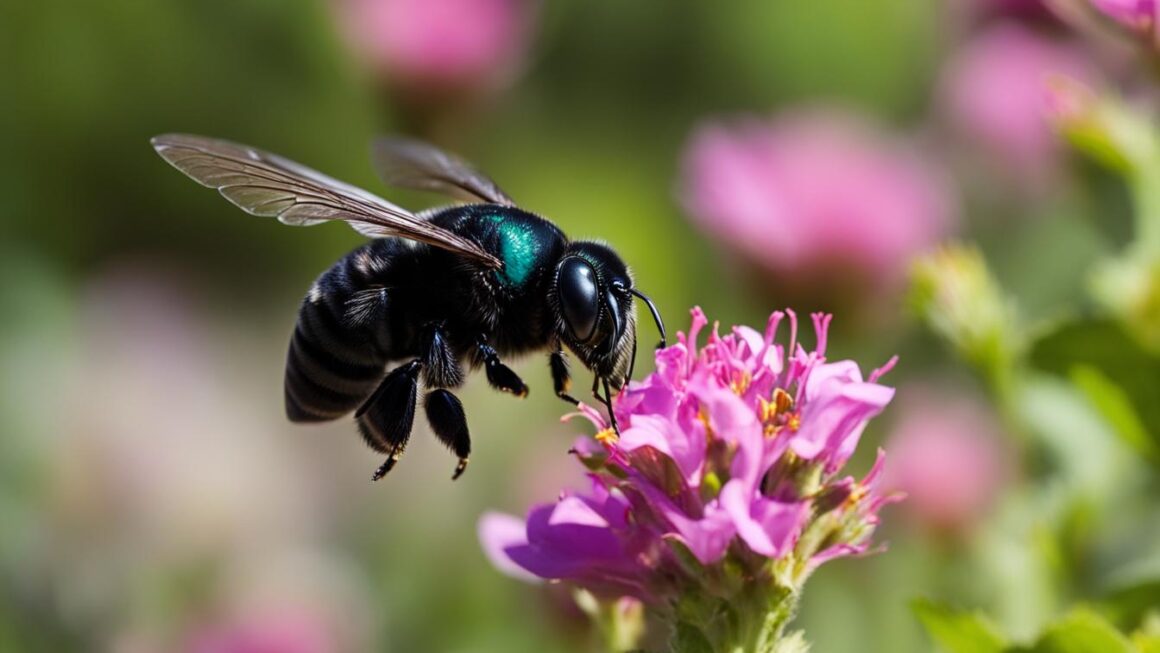Black Carpenter Bees, also known as wood bees, are fascinating insects that are often found around wooden areas of homes, sheds, and wood piles. These stinging insects are around 1 inch in length and can be solid black or black and yellow. But do they actually sting? Let’s discover the truth.
While carpenter bees may look intimidating, they are generally non-aggressive. Female carpenter bees have the ability to sting if provoked, but they are unlikely to do so unless handled or if someone pokes their fingers into their burrows. It’s important to respect their space and avoid unnecessary interactions.
Male carpenter bees, on the other hand, do not have stingers and are harmless. They often exhibit territorial behavior to protect their nests, but they won’t sting. So, if you come across a black carpenter bee, there’s no need to panic.
Key Takeaways:
- Black Carpenter Bees are generally non-aggressive and unlikely to sting unless provoked.
- Female carpenter bees can sting if handled or if their burrows are disturbed.
- Male carpenter bees do not have stingers and are harmless.
- Avoid unnecessary interactions with carpenter bees to prevent stings.
- Respecting their space and observing from a distance is the best approach when encountering black carpenter bees.
What Are Carpenter Bees and How Do They Look?
Carpenter bees, also known as wood bees, are insects that burrow and nest in wood. They are commonly found in and around wooden areas such as homes, sheds, and wood piles. The entrance to their burrows is typically round holes that are about the size of a finger. Carpenter bees come in different colors, with some being solid black and others being black and yellow.
Unlike bumblebees, carpenter bees have hairless abdomens that are shiny black. They are approximately 1 inch in length. The shiny black abdomens are a distinct feature that sets them apart from other bees. These bees are specifically adapted for wood-boring, making them experts at excavating and burrowing into wooden structures.
“Carpenter bees have hairless abdomens that are shiny black, making them easily distinguishable from other bees.” – Bee Enthusiast
Characteristics of Carpenter Bees:
- Size: Approximately 1 inch in length
- Appearance: Solid black or black and yellow coloration
- Abdomen: Shiny black and hairless
- Wood-boring: Adapted for excavating and burrowing into wood
Table: Carpenter Bee Appearance Comparison
| Characteristics | Carpenter Bees | Bumblebees |
|---|---|---|
| Size | Approximately 1 inch | Varies |
| Coloration | Solid black or black and yellow | Varies (often yellow and black striped) |
| Abdomen | Shiny black and hairless | Fuzzy and hairy |
| Burrowing Behavior | Excavates and burrows into wood | Nests underground or in abandoned rodent burrows |
Overall, carpenter bees are unique insects that have adapted to thrive in wooden environments. Their distinctive appearance and wood-boring behavior make them fascinating subjects of study for entomologists and nature enthusiasts alike.
Are Carpenter Bees Pollinators?
Carpenter bees, like honey bees and bumble bees, play a vital role in pollination. They actively gather pollen and nectar to feed their larvae, creating a special substance known as “bee bread.” This bee bread, consisting of a combination of pollen and regurgitated nectar, is then used to cross-pollinate other plants and ensure their healthy reproduction. Therefore, carpenter bees are considered important pollinators in various ecosystems.
Unlike honey bees and bumble bees, carpenter bees have a unique ability to buzz pollinate. Buzz pollination occurs when the bee rapidly vibrates its flight muscles while clinging to a flower, causing the pollen to dislodge and fall onto the bee’s body. This technique allows carpenter bees to effectively collect and distribute pollen, facilitating cross-pollination among different plant species.
It’s important to note that while carpenter bees are beneficial pollinators, they can also cause structural damage to wooden structures when they burrow and nest. However, with proper preventative measures, such as sealing openings and treating wood surfaces, it is possible to minimize their impact while still acknowledging their vital role in pollination.

Table: Differences Between Carpenter Bees and Other Pollinators
| Characteristic | Carpenter Bees | Honey Bees | Bumble Bees |
|---|---|---|---|
| Pollination Technique | Buzz Pollination | Brush Pollination | Brush Pollination |
| Nest Location | Wooden Structures | Hives | Underground or Aboveground Nests |
| Stinging Behavior | Female carpenter bees can sting if provoked | Females can sting to defend the hive | Females can sting to defend the nest |
| Appearance | Black or black and yellow | Black and yellow or brown | Black and yellow or orange |
Do Carpenter Bees Sting, and How to Prevent Carpenter Bee Infestation?
Female carpenter bees have the ability to sting if provoked, but they are generally non-aggressive and will only sting if handled or if someone pokes their fingers into their burrows. The sting can cause discomfort and pain, similar to other bee stings. However, it is important to note that male carpenter bees do not have stingers.
To prevent carpenter bee infestation, there are several steps you can take. Firstly, it is recommended to paint or stain the exposed wood surfaces of your home, as carpenter bees are known to prefer untreated wood. By adding a protective layer of paint or stain, you can make the wood less attractive to these insects. Additionally, it is important to close openings such as garage doors and windows during nesting season to prevent carpenter bees from entering your property.
Eliminating attractants can also help in preventing carpenter bee infestations. Avoid leaving sugary drinks and fruits near your home, as these can attract bees. By removing potential food sources, you can reduce the likelihood of carpenter bees being attracted to your property. It is also advisable to regularly inspect your home for any signs of carpenter bee activity, such as round holes in wood surfaces. If you notice any signs, take prompt action to prevent further infestation.
In conclusion, while carpenter bees have the ability to sting if provoked, they are generally non-aggressive and only sting when threatened. By taking preventive measures such as painting or staining wood surfaces, closing openings, and eliminating attractants, you can minimize the risk of carpenter bee infestation and ensure a peaceful coexistence with these fascinating insects.
How to Control Carpenter Bees?
Carpenter bees are beneficial pollinators, so it is generally best to leave them alone if possible. However, if control measures are necessary, steps can be taken to deter them. Here are some effective methods to control carpenter bees:
- Paint or Varnish: Carpenter bees are attracted to untreated wood. By painting or varnishing exposed wood surfaces, you create a slick surface that carpenter bees have trouble latching onto.
- Close Openings: Keep openings in wooden structures closed during nesting season to prevent carpenter bees from entering and building their nests.
- Cover Sugary Drinks: Carpenter bees are drawn to sugary drinks. By covering them or keeping them away from areas where carpenter bees are active, you can discourage their presence.
- Seal Trash Cans: Carpenter bees may be attracted to trash cans that contain food residue. Make sure to seal trash cans tightly to prevent carpenter bees from accessing the food source.
It’s important to note that carpenter bees are beneficial pollinators, so it’s generally recommended to coexist with them whenever possible. However, if their presence becomes a problem or poses a threat, implementing these control measures can help deter carpenter bees.

Testimonial from an Expert
“Carpenter bees play an important role in pollination, so it’s always best to consider alternative control methods before resorting to more aggressive measures. Simple steps like painting or varnishing exposed wood surfaces can go a long way in deterring carpenter bees without harming them.” – Dr. Emily Peterson, Entomologist
How to Treat Carpenter Bee Stings?
If you have been stung by a carpenter bee, it is important to take the proper steps to treat the sting and alleviate any discomfort. Follow these guidelines:
- Remove the stinger: Just like with other bee stings, the first step is to remove the stinger if it is still embedded in your skin. Use a pair of tweezers or scrape it off gently with a credit card.
- Wash with soap and water: Thoroughly clean the affected area with soap and water to reduce the risk of infection. This will help remove any residual venom and debris.
- Apply an ice pack: To reduce swelling and ease pain, apply a cold compress or ice pack wrapped in a thin cloth to the affected area. Leave it on for 10 to 15 minutes at a time, and repeat every few hours as needed.
- Take pain medication: Over-the-counter pain relievers, such as ibuprofen or acetaminophen, can help alleviate any pain or discomfort caused by the sting. Follow the recommended dosage instructions.
It is important to note that most carpenter bee stings are not serious and can be treated at home. However, if you experience symptoms of an allergic reaction, such as difficulty breathing, hives, or swelling of the face and throat, seek immediate medical attention. In rare cases, carpenter bee stings can cause anaphylaxis, a severe and potentially life-threatening allergic reaction.
Remember to always exercise caution around carpenter bees and other stinging insects to prevent stings. If you have a known allergy to bee stings, carry an epinephrine auto-injector (EpiPen) with you at all times and seek emergency medical services immediately after administering it in case of a severe allergic reaction.
How to Identify Carpenter Bees and Prevent Damage?
To effectively prevent damage caused by carpenter bees, it is important to be able to identify them and understand their nesting habits. Carpenter bees are typically found around wooden structures such as decks and pergolas. They can be identified by their large size, black color, and shiny abdomens. One key characteristic of carpenter bees is the presence of small holes in the wood, which serve as their nest sites. These holes are typically about the size of a finger and are round in shape.
To prevent carpenter bee damage, one effective measure is to stain the wood. Staining the wood creates a deterrent for carpenter bees, as they prefer untreated wood. Additionally, patching any damaged wood using putty can help prevent further damage from weathering and other insects.
| Identification | Prevention |
|---|---|
| Carpenter bees are large, black insects with shiny abdomens. | Stain the wood to deter carpenter bees. |
| Small round holes in wood serve as nest sites for carpenter bees. | Patch damaged wood using putty to prevent further damage. |
By being able to identify carpenter bees and take preventative measures, you can effectively protect your wooden structures from damage. Staining the wood and patching any damaged areas will help deter carpenter bees and ensure the longevity of your wood.
When and Where to Encounter Carpenter Bees?
Carpenter bees are most commonly encountered around wooden structures, such as decks, pergolas, and fences. They are attracted to these areas because they provide ideal nesting sites and sources of food. The sound of buzzing near wooden structures is often an indication of carpenter bees nearby. It is important to note that their territorial behavior may lead to encounters, especially during the spring mating season.
Male carpenter bees, although they do not have stingers, can behave aggressively when defending their territory. They may dive towards intruders, hover close to them, or emit loud buzzing sounds to intimidate. While they cannot sting, it is best to avoid unnecessary interactions with male carpenter bees to prevent any distress.
To minimize encounters with carpenter bees, it is advisable to avoid high-traffic areas where these insects have built their nests. If possible, try to create a buffer zone by keeping wooden structures away from frequently used spaces. This can help reduce the chances of accidental encounters and potential disturbances.
Table: Tips to Avoid Carpenter Bee Encounters
| Tip | Description |
|---|---|
| Avoid High-Traffic Areas | Stay away from areas where carpenter bees have built their nests, especially during the spring mating season. |
| Keep Wooden Structures at a Distance | Create a buffer zone by placing wooden structures away from frequently used spaces, reducing the chances of accidental encounters. |
| Monitor Wooden Areas | Regularly inspect wooden structures for signs of carpenter bee activity, such as round holes or sawdust near the entrances of their burrows. |
| Implement Preventive Measures | Apply paint or stain to wooden surfaces, as carpenter bees are less attracted to treated wood. |
| Seek Professional Assistance | If carpenter bee infestations become unmanageable, consult with pest control experts for effective removal and prevention strategies. |
By following these tips and being aware of the behavior and tendencies of carpenter bees, you can minimize encounters and enjoy a more peaceful coexistence with these wood-boring insects.
Conclusion
Carpenter bees can exhibit stinging behavior if provoked, although they are generally non-aggressive. It is important to be able to identify these insects and take appropriate measures to prevent damage and ensure a harmonious coexistence.
By understanding the behavior and habits of carpenter bees, it is possible to implement effective prevention strategies. This includes taking steps such as painting or staining wooden surfaces, keeping openings closed, and eliminating attractants.
If encountered, it is advisable to exercise caution and maintain a respectful distance from carpenter bees and their nests. If stung, prompt treatment, such as removing the stinger, washing the area, and applying ice, can help alleviate discomfort.
In conclusion, knowing how to recognize carpenter bees, implementing preventive measures, and understanding the appropriate treatment can contribute to a safe and informed approach to dealing with these fascinating insects.
FAQ
Do black carpenter bees sting?
Yes, female carpenter bees can sting if provoked, but they are not aggressive and are unlikely to sting unless handled or if someone pokes their fingers into their burrows. Male carpenter bees do not have stingers.
What are carpenter bees and how do they look?
Carpenter bees, also known as wood bees, are insects that nest and burrow in wood. They are commonly found around wooden areas of homes, sheds, and wood piles. They are around 1 inch in length and can be either solid black or black and yellow. Carpenter bees have hairless, shiny black abdomens.
Are carpenter bees pollinators?
Yes, carpenter bees, like honey bees and bumble bees, play a role in pollination. They gather pollen and nectar for their larvae, which is made into a special “bee bread”. This bee bread helps in cross-pollinating other plants, making carpenter bees important pollinators.
Do carpenter bees sting, and how to prevent carpenter bee infestation?
Female carpenter bees can sting if provoked, but they are generally non-aggressive. To prevent carpenter bee infestation, it is recommended to paint or stain the exposed wood surfaces of homes as carpenter bees prefer untreated wood. Keeping garage doors and other openings closed during nesting season and eliminating attractants such as sugary drinks and fruits near the home can also help prevent carpenter bee infestations.
How to control carpenter bees?
While carpenter bees are beneficial pollinators, if control measures are necessary, steps can be taken to deter them. This includes painting or varnishing exposed wood surfaces to create a slick surface that carpenter bees have trouble latching onto. Keeping openings closed during nesting season, covering sugary drinks and fruits, and sealing trash cans can also help discourage carpenter bees.
How to treat carpenter bee stings?
If stung by a carpenter bee, it is important to first remove the stinger if it is still embedded in the skin. The area should then be washed with soap and water. Applying an ice pack can help relieve swelling, and over-the-counter pain medication can be taken as needed. In rare cases of an allergic reaction, emergency medical services should be called.
How to identify carpenter bees and prevent damage?
Carpenter bees can be identified by their large size, black color, and shiny abdomens. They are commonly found around small holes in wood structures, particularly softwoods like cedar and redwood. To prevent damage, staining the wood can act as a deterrent. Patching damaged wood using putty can also help prevent additional damage from weathering and other insects.
When and where to encounter carpenter bees?
Carpenter bees are most likely to be encountered around wooden structures such as decks and pergolas. They are active during spring and can be found near their wood-boring holes. Male carpenter bees may exhibit territorial behavior but do not have stingers and are generally non-aggressive. To avoid encounters, it is recommended to stay away from wood structures where carpenter bees have built their nests.
Conclusion
Understanding carpenter bees can help ensure a safe and respectful coexistence with these fascinating insects. They are non-aggressive pollinators that can sting if provoked, but prevention methods and treatment options are available. Identifying carpenter bees and taking steps to deter them can help protect wooden structures from damage. If stung, prompt treatment is necessary to alleviate discomfort. Overall, carpenter bees are an important part of the ecosystem and should be respected and appreciated.




